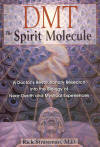
What is a little-known, pea-sized gland revered by
metaphysicians for millennia and nicknamed the third eye or the
seat of the soul? It is the pineal gland, located in the middle
of the head, occupying a masterful position in regulating human
function.
This two-part article discusses this all-important
gland and how pineal dysfunction is associated with both cervical spinal
cord injury (SCI) and multiple sclerosis (MS). Part 1 will first discuss
the pineal gland from scientific and mythological perspectives, and then
from an outlook that bridges these seemingly irreconcilable viewpoints.
Pineal Gland & Melatonin
Named because it resembles a pinecone, the pineal
gland is the size of a little finger nail. In spite of its mid-brain
location, the gland is not part of the brain and resides outside of the
blood-brain barrier. Some believe it develops from fetal tissue
associated with the mouth.

Until relatively recently, the pineal gland was
considered a vestigial organ lacking function, i.e., the brain’s
appendix. Then scientists showed it produced melatonin, a hormone that
profoundly affects us. The pineal gland converts the amino acid
tryptophan into serotonin (a neurotransmitter) and, in turn, melatonin.
The melatonin then is released into the bloodstream and cerebrospinal
fluid where it is transported throughout the body.
The release is closely correlated to our sleep-wake
cycle. Readily available as a sleep-aid for insomniacs, melatonin
production is inhibited by light and stimulated by darkness. It peaks in
the middle of the night, and more is produced in winter’s darkness.
Through complicated neuroanatomical wiring, photosensitive retinal cells
detect light and send signals to structures that regulate our 24-hour
circadian rhythms. These signals exit the head to the cervical spinal
cord (hence, SCI’s potential impact), where are they are routed back to
the pineal gland.
The gland is also sensitive to electromagnetic
energy. For example, melatonin production changes in response to the
earth’s magnetic field and is closely correlated to geomagnetic latitude
(an issue with MS). Researchers have actually found magnetite clusters
near the pineal gland. Like homing pigeons, humans have residual ability
to orient to geomagnetic directional cues, an ability lost with pineal
dysfunction.
In addition to influencing sleep cycles, melatonin
exerts numerous other important physiological influences, such as
regulating sexual and reproductive function and development.
Pineal functioning tends to diminish over time. In
adults, melatonin-compromising calcification of the pineal gland is not
uncommon, a process in which gritty deposits called brain sand
accumulate.
Scientists believe that some of this calcification
is due to drinking-water fluoridation. Because the gland accumulates
fluoride, it contains the body’s highest fluoride concentration.
Research shows that this accumulation depresses melatonin synthesis with
adverse consequences such as accelerating puberty onset.
This issue may have ramifications for individuals
sustaining a SCI. Specifically, animal studies suggest that melatonin is
neuroprotective, and reduced pineal production may make
one more vulnerable to injury and, in turn, paralysis. Although I’m
reluctant to question sacred-cow public-health policies, it is
staggering to think that readers might be more paralyzed due to our
efforts to fight cavities.
Metaphysical
The energy-sensitive pineal gland has a rich
metaphysical history. Throughout the ages, it has been assigned a
spiritual role that transcends its hormonal function. In Hindu
traditions, it’s associated with the extrasensory third eye of which
perception of the world is not limited to the physical senses. For
example, the God Shiva is portrayed with a third eye in the forehead.
The pineal gland is linked with the crown chakra called the Thousand
Petaled Lotus, which transforms and downloads energy from the ethers
into our consciousness.
At some level, these insights resonate with
biological observations noting a light-sensitive, pineal-linked third
eye in some animals, such as certain lizards and fish. However, for
species further up the evol utionary
ladder, the pineal gland has receded deep into the brain.
utionary
ladder, the pineal gland has receded deep into the brain.
French philosopher René Descartes (1596-1650)
emphasized the pineal gland in his writings, calling it the seat of
the soul and “The part of the body in which the soul directly
exercises its functions.”
In The Secret Doctrine (1888), Helena
Blavatsky, cofounder of the Theosophical movement, described the gland’s
role in an evolutionary context, in which mankind evolved over the eons
from more energy-based beings to ones of dense physicality.
 As
a result of this physical metamorphosis, the gland’s energy-receiving
role receded:
As
a result of this physical metamorphosis, the gland’s energy-receiving
role receded:
·
“the third eye acted no longer,” … because man had sunk too deep
in the mire of matter.”
·
“The third eye …gradually petrified soon disappeared …the eye was
drawn deep into the head and is now buried under the hair...”
·
“…owing to the gradual disappearance of spirituality and increase
in materiality…, it became an atrophied organ.”
·
"The third eye is dead…but it has left behind a witness to its
existence…the pineal gland.”
Interestingly, there is a correlation between the
soul’s emergence in various spiritual traditions and pineal formation.
Specifically, the gland first appears in the fetus 49 days after
conception. This is the time Tibetan Buddhists believe it takes after
death for the soul to finish its sojourn and reincarnate into the next
body. This period also approximates the 40 days espoused by early
Christians, such as St. Augustine, that it takes for the soul to enter
the fetus.
The Spirit Molecule
New paradigms are emerging that may reconcile some
of the mythological and scientific viewpoints on the pineal gland.
Based on understandings gained from his federally
funded research, Dr. Rick Strassman (New Mexico) wrote DMT The Spirit
Molecule: A Doctor’s Evolutionary Research into the Biology of
Near-Death and Mystical Experiences (2001). In this book, Strassman
speculated how the pineal gland has considerable metabolic potential to
produce a powerful psychedelic called DMT and that D MT
expression may be amplified at “extraordinary times in our lives,” such
as death (or near-death), birth, and transcendent mystical experiences.
Others suggest that pineal-produced DMT stimulates dreaming.
MT
expression may be amplified at “extraordinary times in our lives,” such
as death (or near-death), birth, and transcendent mystical experiences.
Others suggest that pineal-produced DMT stimulates dreaming.
Such mystical themes also have been recently
highlighted in Spirituality & Health magazine (March-April 2009),
and a National Public Radio feature “The God Chemical: Brain Chemistry
and Mysticism” (www.npr.org).
DMT is structurally similar to melatonin. The
biochemical precursor to both molecules is serotonin, a key
neurotransmitter whose pathways are involved in mood and targeted in the
treatment of psychiatric disorders. DMT also structurally resemblances
other psychedelic drugs, such as LSD and psilocybin, and is the active
agent in ayahuasca brew Amazon shamans use to provoke out-of-body
experiences. Like many mood-controlling pharmaceuticals (e.g., Prozac),
these psychedelics act through interacting with serotonin-associated
pathways.